Beyond Stable Images
Interview with Claire Tancons
January 17, 2020interview,
The remainder of the Emirates’ cool breeze welcomed curator and scholar Claire Tancons’ Look for Me All Around You, one of the three independently curated platforms of Sharjah Biennial 14, in early March last year. Identified by the biennial-going international art crowd to possess ‘a strong performative bent’1, the reading consistently aligns with Tancons’ methodology in relocating the act of looking ‘towards the aural’ and in reiterating the space of feeling in the vibrations of the echo within the infrastructures of global exhibition-making.
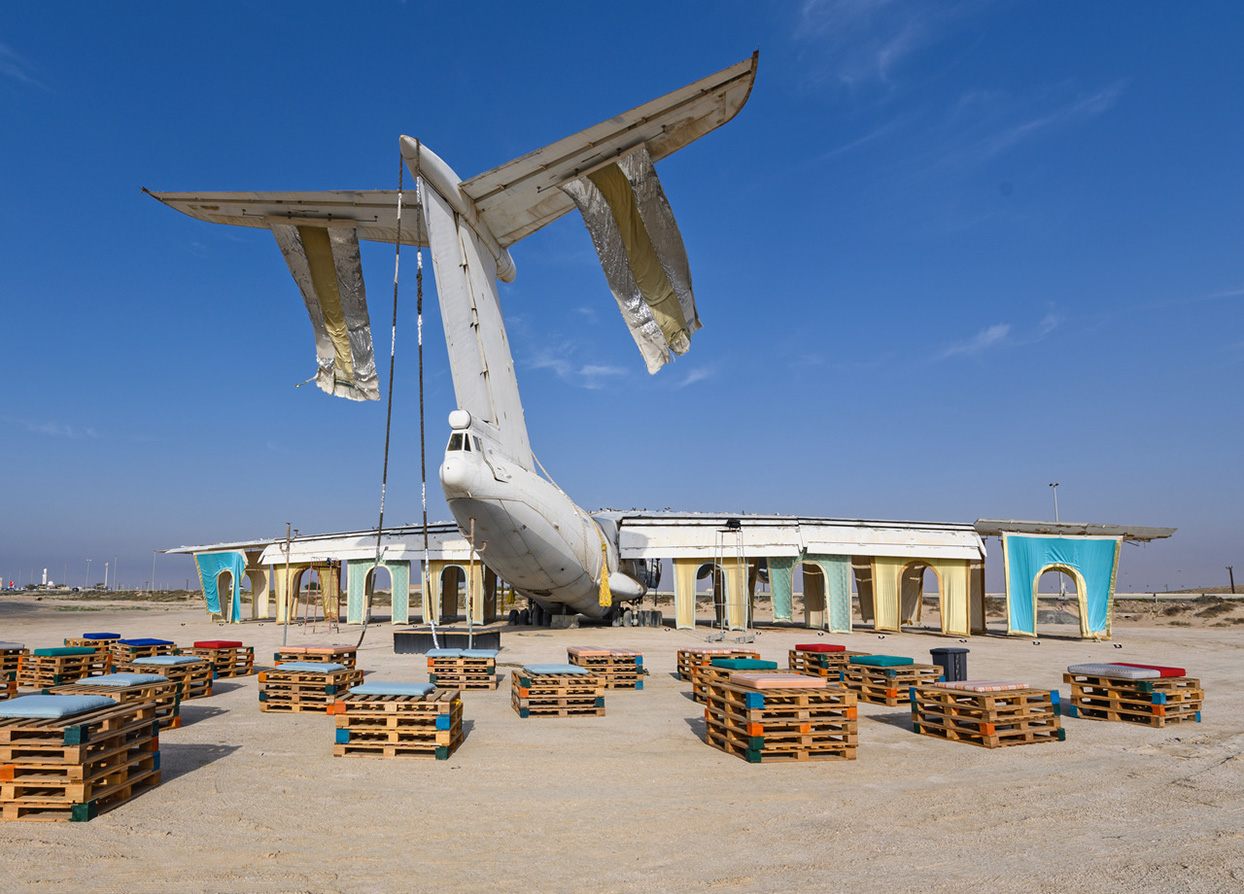
Look for Me All Around You produced 27 new commissions for the biennial’s title Leaving the Echo Chamber, a familiar call for critical consciousness and action in our disjunctive historical moment of diminishing democratic values and invigorating fascist possibilities. Tancons’ diasporic work-in-situ has enabled her to form a curatorial milieu in performance that traces and highlights a scholarship that privileges African diasporic practices. With the positive valence of neoliberal mobility and networking, Tancons has smuggled these modes of decentering and othering curatorial methodologies in emerging biennials and large-scale productions. For Sharjah Biennial, these commitments have been tested in the sites of an emirate co-evolving and forming its structures and constraints of what a contemporary civil society could be.
In this interview, conducted between January and December 2019, the task of understanding Tancons’ practice and Sharjah Biennial platform is a deliberate measure of coinciding her inquiries and proposals with other narratives of redemption and resistance, i.e., all the way south to insular South East Asia. This chance is a collaborative opportunity of deepening counter-histories, pronouncing the utopic aspiration for supremacy yet knowingly keen on its status as a virtually unstable fellowship of strategies and positions. The disaffection with the dominant nomenclature of ‘minor histories’ and the essentialist demand of narration reconfigure here as a re-potentialized albeit ‘obscure’ project of enlightenment from the low: a call for translation and interruption through multi-vocal agencies across many time-space continuums.
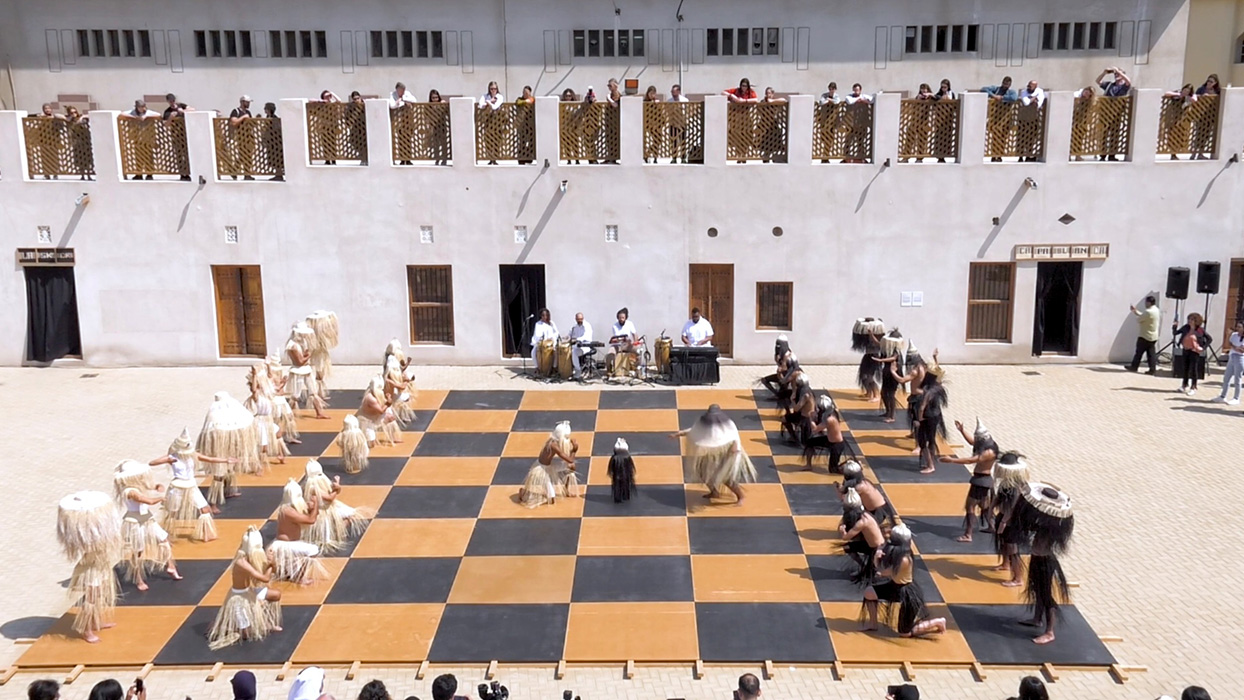
Renan Laru-an: The frame of your curatorial venture Look for Me All Around You, in last year’s iteration of the Sharjah Biennial has brought me into thinking about a distant reference congruent to Marcus Garvey’s ‘First Message to the Negroes of the World from Atlanta Prison’ (1925). It is a speech delivered by Wenceslao Vinzons, a law student at the University of the Philippines who later led an armed resistance against the Japanese occupation of the Philippines. Titled ‘Malaysia Irredenta’ (1932), he called for the organization of maritime South East Asia with ‘Malay-ness’ as their common bond to establish a unifying republic, an idea already broached numerous times in established governments like Hawaii in 1879 and by revolutionary leaders like Apolinario Mabini in 1898. The passage that strikes me, almost producing a filial reverberation with Garvey’s invocation of ‘looking around’, is committed to the same conception of a present future: ‘With the instinct of the man in the last death throes with the waves, we look in the waters around us.’ Both men asked us to never stop engaging with the forces that govern and oppress us: whirlwind, storm, waves. Concretely, both leaders and thinkers proposed their ‘United States’ – Garvey’s United States of Africa (1924) and Vinzons’ United States of Malaysia (1932). These voices are clearly calling for the redemption of race. I am wondering about the dynamics of these voices and their movement with images whose opaqueness is prolonged, or with images that refuse to reveal themselves.
Claire Tancons: Such historical synergies between Garvey and Vinzons, the former a Jamaican political activist dreaming up from Harlem about a united African front and the latter a politicized Filipino student fighting his way through the possibility of a grand ‘Malaysia’ are critical sources for the consideration of a global history that gets too often collapsed into grand narratives rather than the counter histories to which they truly belong. Speaking about Garvey, whom I know best of the two, he certainly was a ‘race man’, believing in the segregation of the black (and, more generally “colored”) man and the white man all the while calling for collaboration with other non-white ‘races’ and making inroads beyond the Americas and towards Africa and Asia.
What kinds of images can counter-histories produce? Can political discourse generate aesthetic material? What are the strategies through which such artistic content get disseminated, assimilated and dissimulated at the same time?
If the twenty-seven newly commissioned works for Sharjah Biennial 14’s Look for Me All Around You were any indication, then dissimulation, or hidden meaning, dissemination, in the form of errantry, if not assimilation, unless, maybe in the landscape, were mobilized to hint at rather than point to, to suggest rather than show, to insinuate rather than tell. Such ‘minor’ strategies or ‘subaltern’ positions while altogether not uncommon and, without overstating the influence of the open curatorial framework of the platform, were indeed, to some extent, the result of at least some of the artists’ reflections upon Garvey’s words, their political charge or poetic dimension. It would be preposterous to think that the biennial’s Look for Me All Around You could possibly act as a retrospective transposition of any political programme or poetic constellation; yet, it does offer the concrete possibility to work from and through a century-old utopian position of emancipation and redemption. Whether the artists had any knowledge of, or interest in Marcus Garvey and his ‘Message’, whether they were intrigued by the poetic dimension of his words and oneiric transport of his promise, or didn’t care altogether, their works did contribute to convey, in however many multifaceted ways, the qualities and sensibilities of a precarious presence on par with the limited manifestation of political utopias.
Garvey’s voice (or words) as a concrete possibility that might have been transmuted in both artistic strategies and content – or perhaps a singularity producing new waves of tremor in artistic thought and practice – shows that a voice as a singularity is constantly differentiated. More than a decade after curating SPRING (2008) for the Gwangju Biennale, in which you explored and materialized artistic production, curatorial engagement and social participation in the registers and merits of (carnival) parade, (mass) demonstration and (funeral) procession, I am very curious if there are recurring collisions between the constantly differentiated voice and the representational device that is the retinal image that you revisited in another context, i.e., Sharjah. Perhaps it is also asking about the contemporary ‘rub’ between the voice and the image.
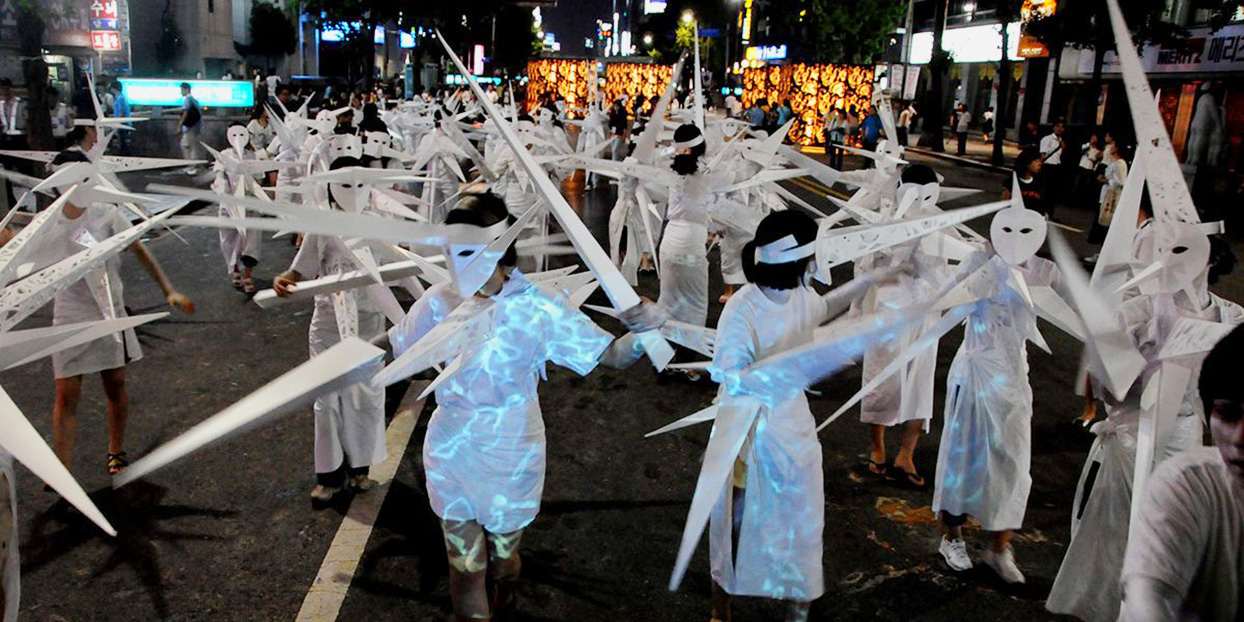
The time and distance between SPRING for the Gwangju Biennale in 2008 and Look for Me All Around You for the Sharjah Biennial in 2019 form a cohesive curatorial arch if a politically paradoxical one. On the one hand, SPRING in Gwangju aimed at chanelling the multitudinous voices of the rebellious students from the May 18 Democratic Uprisings of 1980, first heard and most resonant from Gwangju. More generally, SPRING was searching for the sounds and gestures of popular upheavals that have historically taken place in Spring, from Paris to Prague, to think of the year 1968 alone. Revolving around Geumnamro, the original location of the historic event, SPRING also attempted to capture the after-images of the uprising and to leave a retinal impact with the thousand-strong processional resonant with the archival documents of this foundational moment in the democratization of South Korea. On the other hand, Look for Me All Around You in Sharjah, as we have begun to discuss, sought to follow a million diasporic voices through the historical whirlwind of a one-man show turned into the multinational spectacle of attempted (black) racial supremacy. Both SPRING and Look for Me All Around You used the curatorial device of the processional performance for the motion of matter, bodies and people, and as movement of people, ideas and culture. In SPRING, this was exclusive in the sense of it being a 100-strong, 90-minute long processional performance made up of 5 processionals. Look for Me All Around You, which comprised geographically distinct and distant locations was strung through the motion of three processional performances by three distinct artists to and from various curatorial coordinates as could be best experienced during the two-day opening. In SPRING time was linear and retrospective, looking back at the (largely lost) emancipatory salvo of (a portion of) the South Korean people. In Look for Me All Around You, the time was disjointed and prospective, eyeing a future that may never be from the rather anti-utopian perspective of a majority-immigrant coalition of minority-own family state corporations that constitute the Emirates. In this future, an unprecedented majority of voices should form images and imagine forms of governance. Should that fail, the rhetoric – let alone the practice of art- and exhibition-making even under the state of exception created by the biennial context – is under suspicion of a collusion with power. In closing, in response to your question, voices were masked and images hushed through the various processes of distanciation or flight, encoding or hiding.
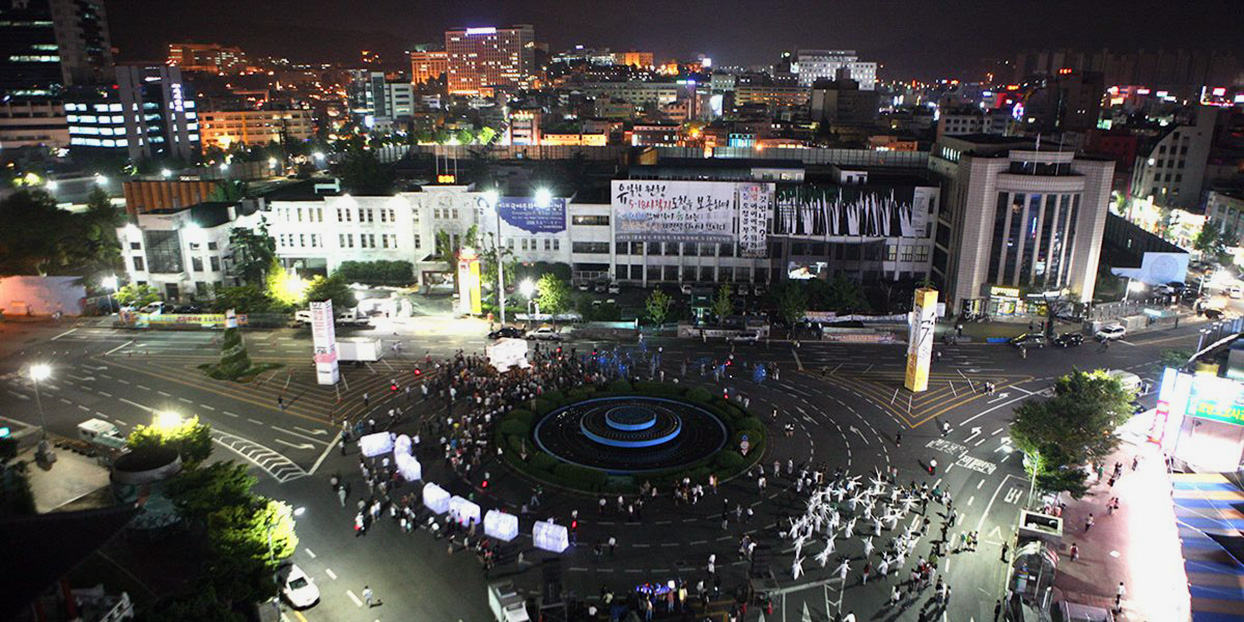
Migrant images and fugitive forms are crucial in animating your exhibition and projects in Sharjah. You are also ushering us into ‘after-forms’ and ‘after-images’ as access points to your mediation with Sharjah as a host of multiple contexts and your collaboration with artists who carry their histories of articulation. This agency to translate elects the curator as a host of migration, one who initiates, maintains and receives migrant bodies and images. The migrant is also a site of refusal. How do you curate this refusal in large-scale projects? And what new refusals can be generated in curatorial practice, and which refusals can be mediated by a curator for them to be critically apprehended then renewed?
Migrant images are, of course, not images of migrants, and fugitive forms are not images of fugitives. I am hesitant to think of the curator as a host to migrant bodies. It is true that some artists did self-consciously elect or less programmatically resort to working with migrant populations. This is the case of New Orleans Airlift’s The Trans-National project in Umm Al Quwain, where several featured guests and participants from migrant backgrounds shared the stage of the utopian space they constructed under a plane, the iconic image of contemporary migration to and from the United Arab Emirates. Additionally, among the large-scale performances, Ulrik López presented dancers from a variety of migrant backgrounds in Patakí 21, Mohau Modisakeng included dancers primarily from African backgrounds in Land of Zanj. Of course, a higher participation of migrants is inevitable in the UAE where the migrant population forms the majority, but also where cultural mores and religious rule do not favour the exhibition of the body. Emirati nationals could more easily be found to fill in as musicians but not as dancers. I wanted to test – and possibly even exhaust – the possibility of public performance with the additional challenge of a public space and civil society divided across and regulated by strict codes of conduct.
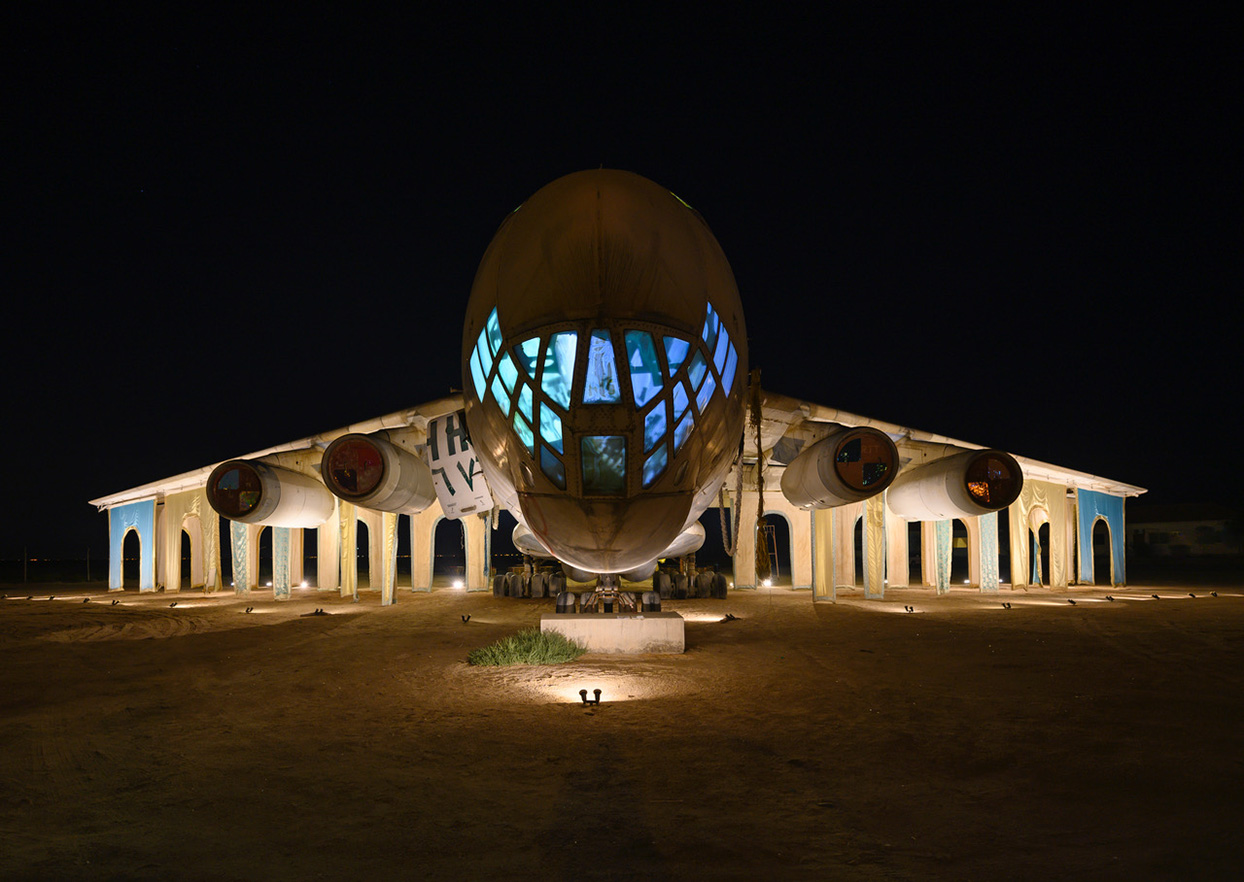
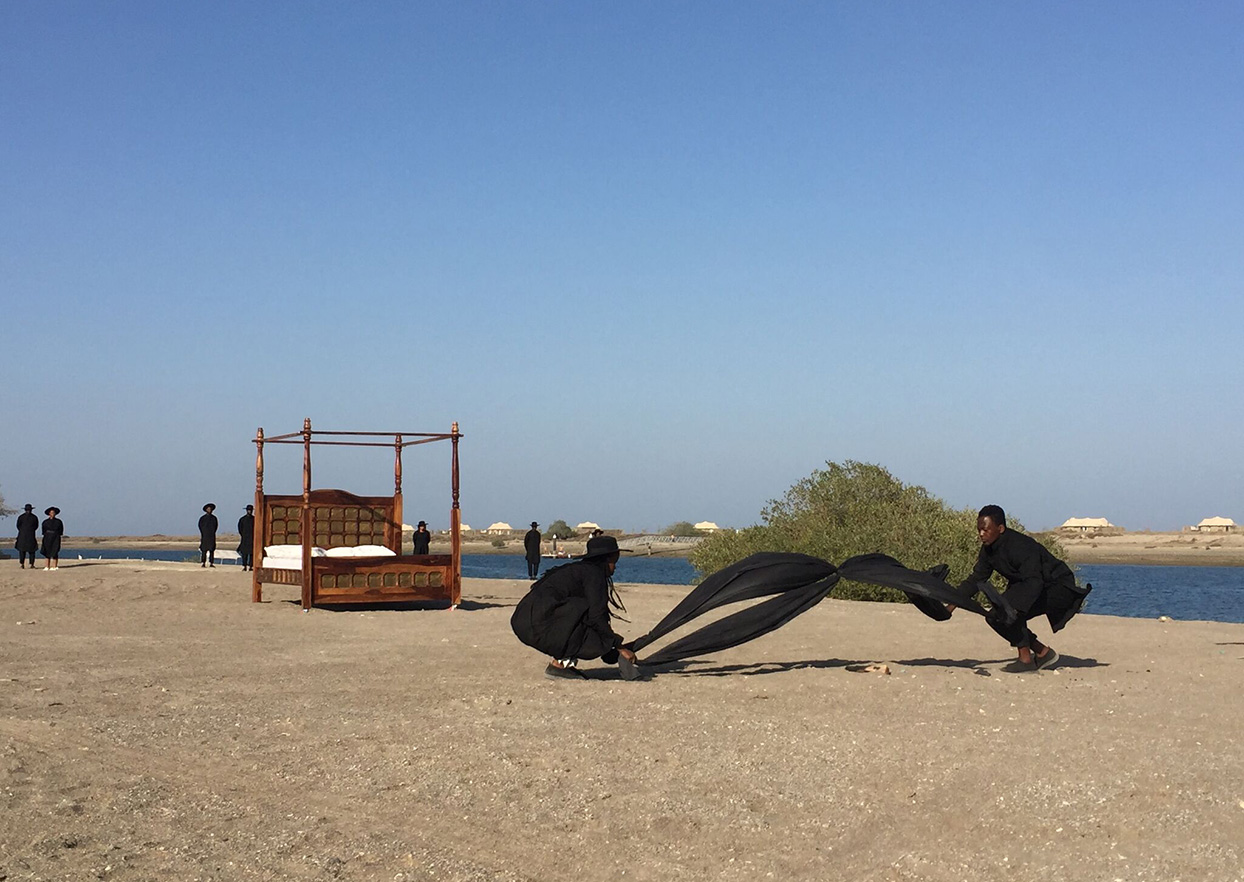
You mentioned that translation may not necessarily occur in spite of the mediation of a curator for reasons such as different constitutions of public space and civil society.2 One of the refusals that I am interested in is the simultaneity of flows against the monologic force of narration. For example, how nation-states are produced by the homogenizing structures of community and narration. Recently, I have been drawn to a local reference orosipon, an old word for story in the Bikol region, south of the Philippines. Its root word osip is not equivalent of ‘tell’, but rather approximates the act of telling in an open and ongoing manner by multiple speakers to no one in particular. The hearer can be the next paraosipon (storytellers) or para-osip (tellers of tale). The simultaneity and equality of translation and interruption in orosipon as a radically and morphologically incomplete dialoguing refuses a complete narration. It also refuses the task of ‘tell me’ only to tell a different story or different stories. I am not sure how to accommodate this question in this limited opportunity, but I am compelled to ask how you to contour (test or exhaust) dialogues, monologues and storytelling in public performances.
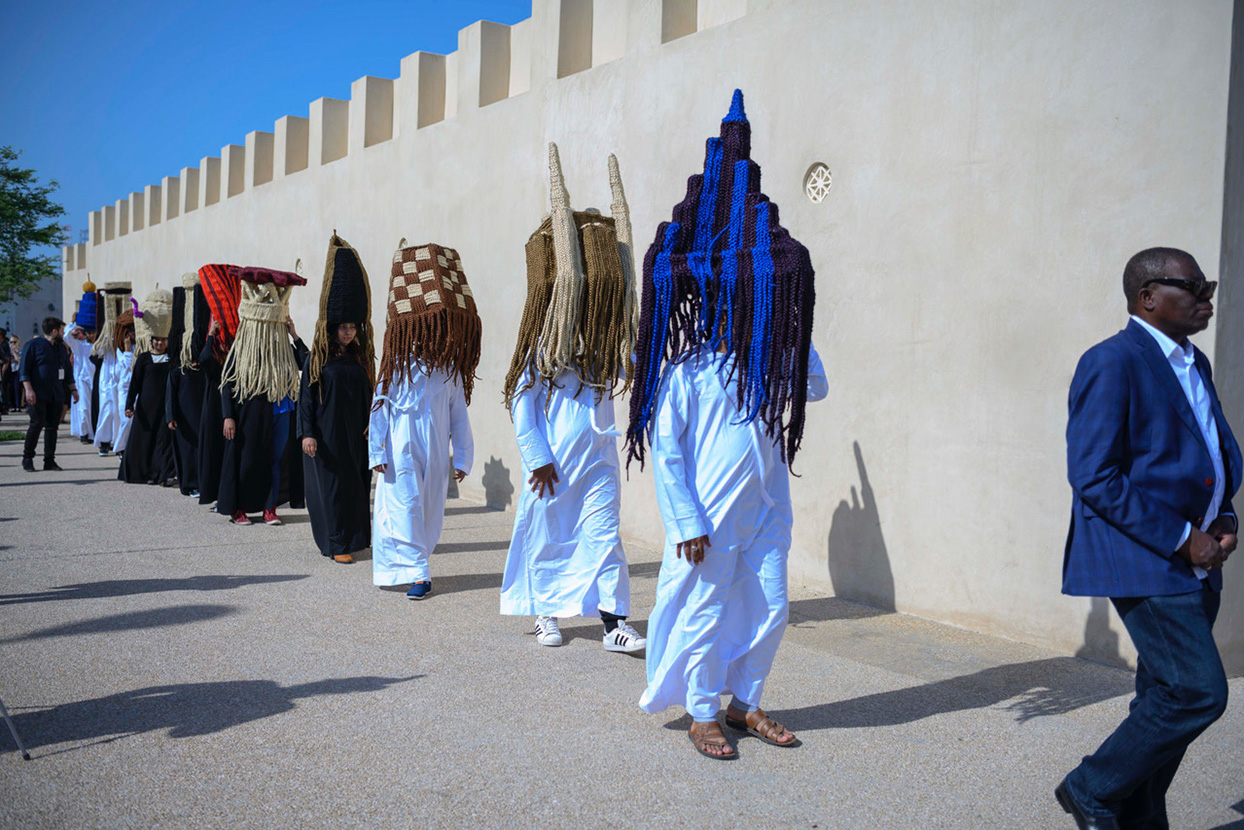
I recently reconnected with the Caribbean form of call-and-response narration I know from the French-creole speaking islands of Guadeloupe, Martinique and Haiti. The first storyteller says yé-cric, and a respondent says yé-crac to indicate their willingness to become part of the story. Then along the course of the story, a simple cric call and a crac response keep the story going and the verb passing from one teller to another. Such dialogical storytelling seems close to that of orosipon in the circulation of voices it encourages and the foreclosure of linear narration it forbids. My reliance upon processional performance to link locations and break distance is predicated upon the urge for multiplicity or the possibility of multiplicity of as many narrative threads as there are moving positions within roving locations. This movement eschews fixity and monolinguality. For instance, in Meschac Gaba’s Défilé de Perruques Émirats Arabes Unis, spectators, onlookers and passers-by develop a vocabulary of places and a sense of the specificity of context as they accrue the ranks of the procession and develop a far greater range of sensorial perception than they would in a static and frontal mode of viewership. Proximity and simultaneity are the measures of multiple modes of narration within a public context of performance.
Your scholarship draws from art historical and cultural studies of performance, performing arts, and citizen movement and organization. All of these have been shaped and inflected by dominant Euro-American discourses and postcolonial and decolonial thinking and action. The hegemon remains as the most concrete fold and vector to engage with. Could you speak more about the emphasis on the ‘after -’ (after-images, after-forms) and other prefixes such as ‘de -’ and ‘re-’ (dispossessive and repossessive disposition) as your ethico-political position, which seems to be a lateral move from the familiar tools of deconstruction, such as the project of ‘counter-’ (counter-images, counter-narratives, counter-mapping)? Perhaps you could also elaborate on how this interplay of directions emerge in the works of artists in the biennial?
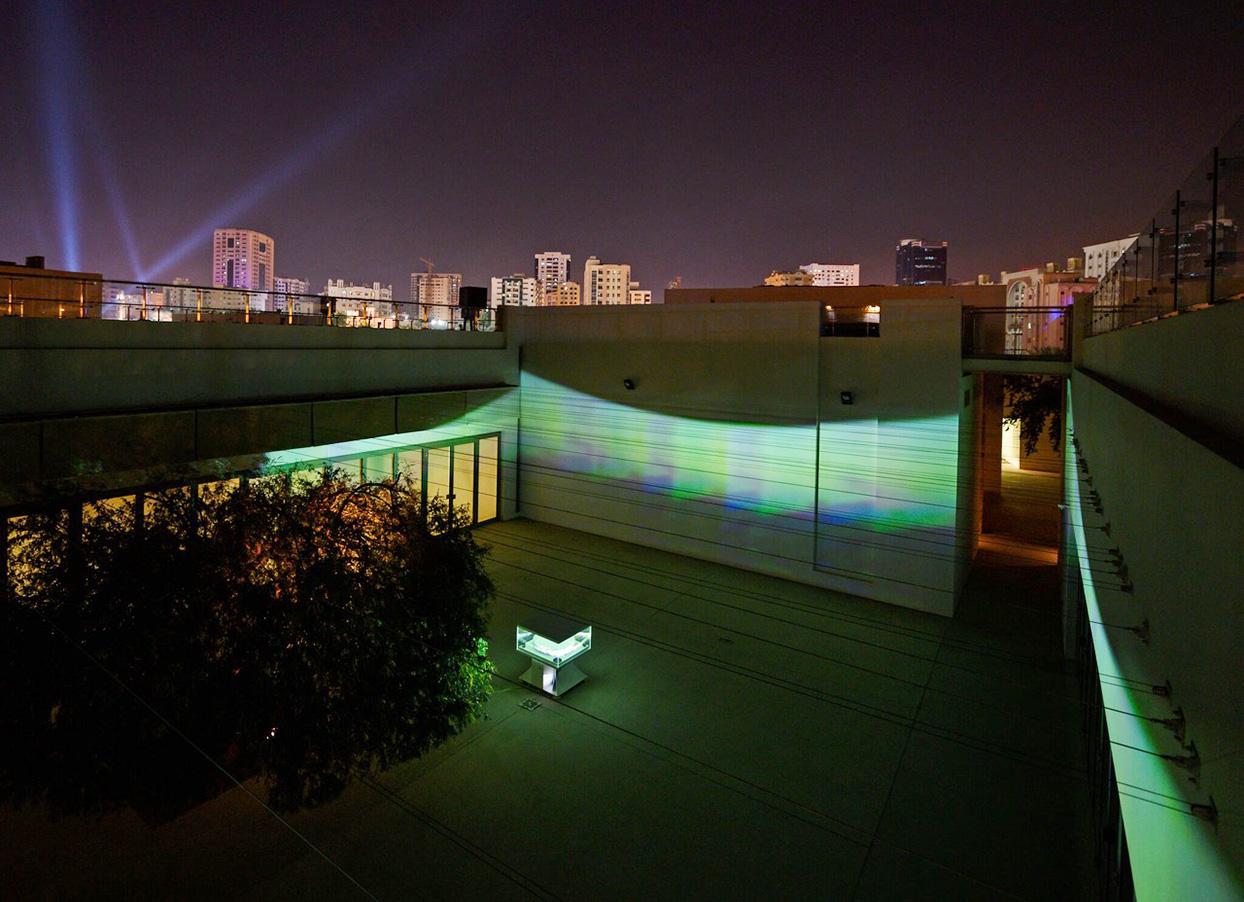
My emphasis on the after-life of the material and the manifest stems from the desire to distance the processes and practices presented in Look for Me All Around You from the artistic status quo It is also coming from the need to disavow negative definitions and characterizations: we have seen this frequently applied to artistic practices perceived to be outside of the mainstream around which the discourse tends to declare what is not versus what is (I am thinking here specifically about the rhetorical negations in the formulation of the title of Berlin Biennial X ‘we don’t need…’ and its programme of talks ‘I am not…’ for instance, to qualify black artistic practices). By looking for what is left after, what is removed (‘de-’) and or what is added (‘re-’) is one way to affirm and inform meaning, to assert and to state knowledge and to leave the confines of the negative and the defensive. Likewise, sidestepping oppositional stances (‘counter-’) aims to create a space of contemplation and suspension from which reflection can take place. Some terms have a particular genealogy, especially as applied to performance, e.g., dispossession with Athena Athanasiou and Judith Butler, or, specifically as applied to a performative genre, which has definite diasporic resonance, the processional, with Homi Bhabha’s processional ethics about William Kentridge’s procession of the dispossessed dating back to apartheid-era internal migrations and forced displacements.
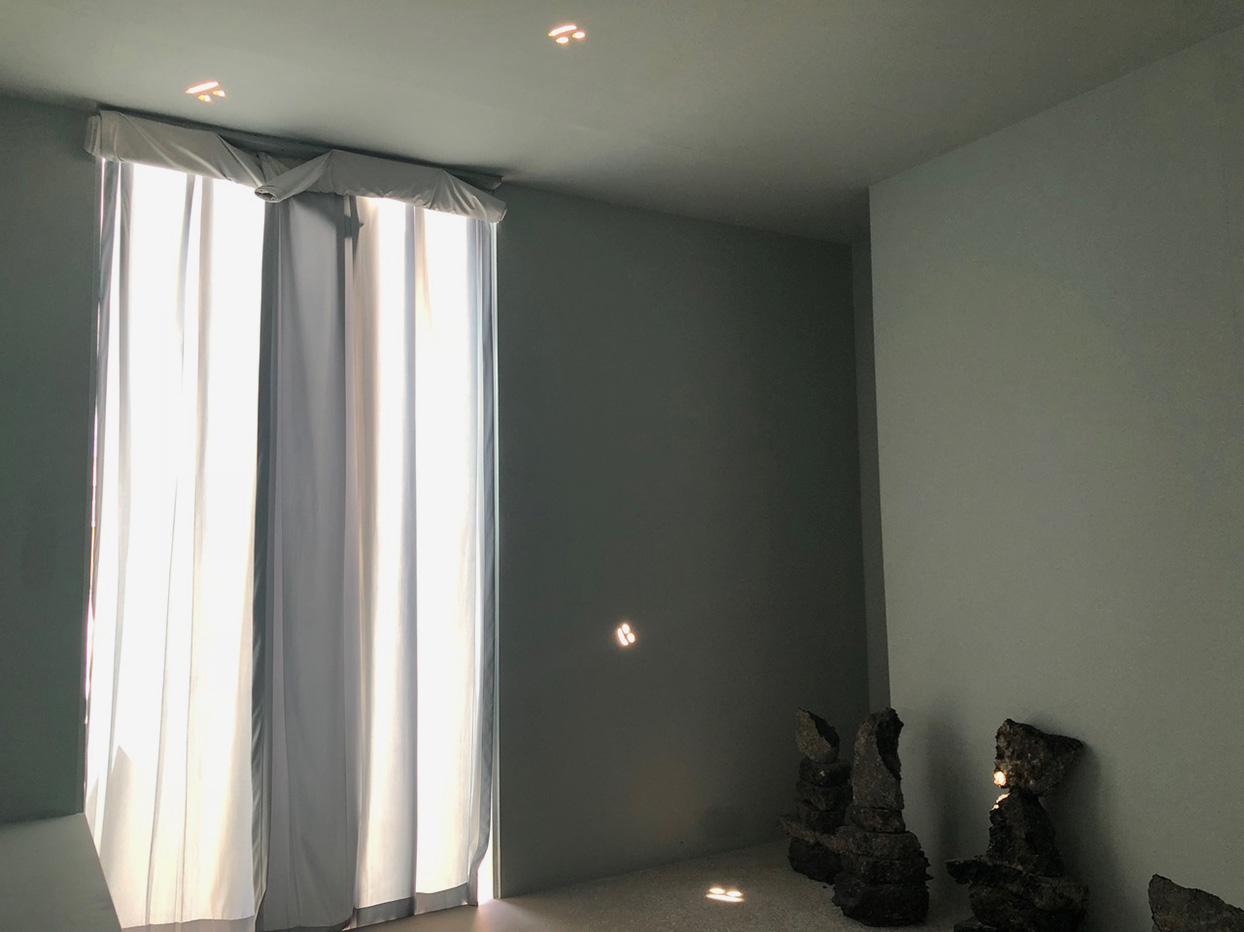
Focusing on traces, remnants and remains is a fundamental and foundational diasporic trope. In Look for Me All Around You, a dismissal of the retinal gave way to a plethora of works whose tangible manifestation was always fragile and febrile, ephemeral and unstable. I am thinking specifically about works related to natural phenomena. As Michael Marder would put it, elemental forces, such as the sun: these works (dis-)appear under certain conditions: Allora & Calzadilla’s noon-time appearance of Specters of Noon, Caline Aoun’s one-hour Beirut / Sharjah sunset time-lag in Time Travel, or Hannah Black and Ebba Fransén Waldhör’s 6-times-a-day sun activations of Suntitled. To these materially fugitive manifestations respond symbolically fugitive performances alluding to the diasporic experience, such as Torkwase Dyson and Dark Adaptive’s I Belong to the Distance. Under such conditions, the after-life is where other forms of life and other lives can begin – beyond the realm of stable images.
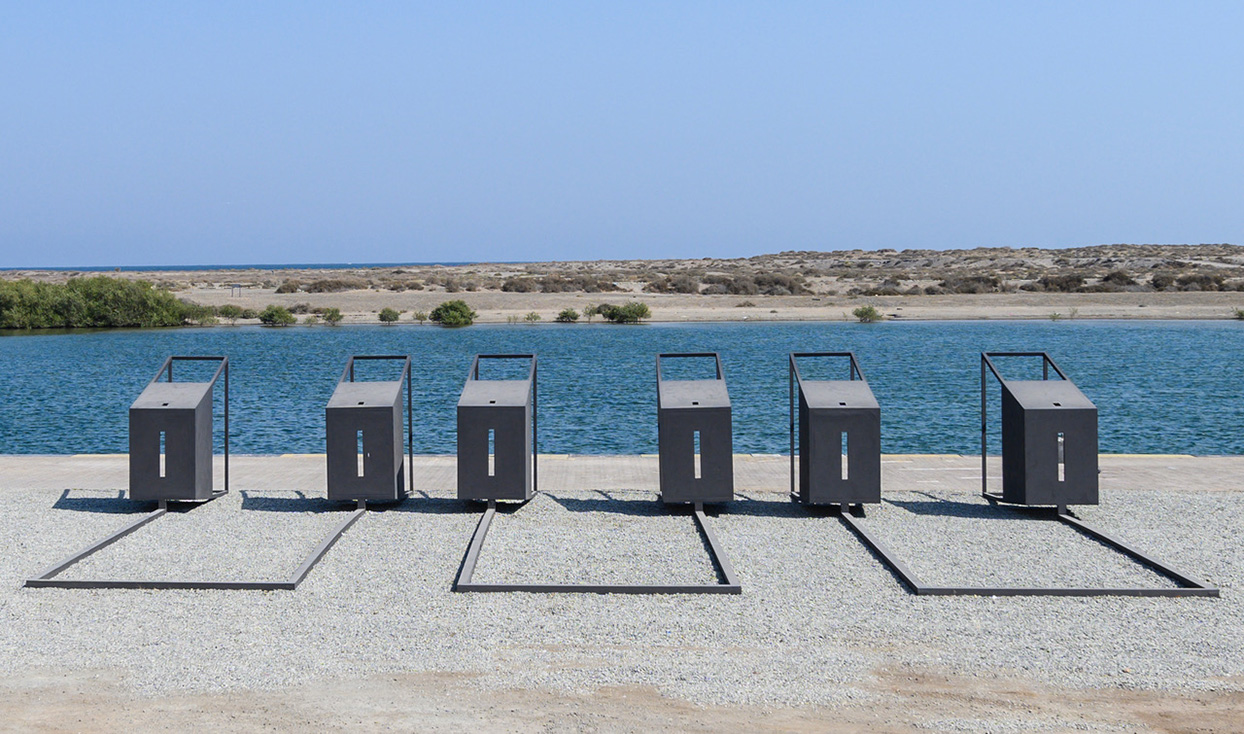
1. Art News, Rahel Aima, 'Productive Friction: An Incisive Sharjah Biennial Ponders the Untapped Histories of the United Arab Emirates', May 28, 2019, artnews.com.
2. C&, Will Furtado, ‘Finding Alternatives to Representation with Claire Tancons’, February 14, 2019, contemporaryand.com.
Renan Laru-an (1989, Sultan Kudarat) is a researcher working curatorially from the Philippines and in Southeast Asia. In 2012, he founded DiscLab | Research and Criticism (2012–2015), a multidisciplinary platform and ‘virtual’ organisation for critical writing, theory, discursive activities and research on Philippine contemporary art as well as visual and network culture. He is currently the Public Engagement and Artistic Formation Coordinator at the Philippine Contemporary Art Network (PCAN). Laru-an studies ‘insufficient’ and ‘subtracted’ images and subjects at the juncture of development and integration projects through long-term inquiries, such as Promising Arrivals, Violent Departures (ongoing), Herding Islands, Rats and the Anthropocene (2015), Lightning Studies: Centre for the Translation of Constraints, Conflicts and Contaminations (CTCCCs) (2016), and The Artist and the Social Dreamer (2017). He has (co-)curated festivals and exhibitions, including the 6th Singapore Biennale: Every Step in the Right Direction, Singapore (2019); the 8th OK. Video – Indonesia Media Arts Festival, Jakarta (2017); A Tripoli Agreement, Sharjah Art Foundation, Sharjah (2018); among others. His independent scholarship has been supported by the Foundation for Arts Initiatives, the National Commission for Culture and the Arts and numerous curatorial residencies and fellowships.
Claire Tancons is a curator and scholar invested in the discourse and practice of the postcolonial politics of production and exhibition. For the last decade, Tancons has charted a distinct curatorial and scholarly path in performance, inflecting global art historical genealogies with African diasporic aesthetics as well as decentering and othering curatorial methodologies as part of a wider reflection on global conditions of cultural production. Tancons co-curated the first edition of Tout-Monde, Caribbean Contemporary Arts Festival (in partnership with the French Embassy Cultural Services, Miami, 2018) and curated etcetera: a civic ritual (Printemps de Septembre, Toulouse, France, 2017). Other curatorial highlights include Tide by Side, the opening ceremony of Faena Art’s Miami Beach district (2016); Up Hill Down Hall, a BMW Tate Live commission in the Turbine Hall, Tate Modern, London (2014) and EN MAS’: Carnival and Performance Art of the Caribbean, organised and presented by Contemporary Arts Center New Orleans and co-organised as a travelling exhibition by Independent Curators International, New York. She has also curated for established and emerging international biennials such Prospect.1 New Orleans and Gwangju Biennale (both 2008), Cape Town Biennial (2009), Biennale Bénin (2012), Göteborg Biennial (2013) and Sharjah Biennial 14 (2019).Over the years, Tancons’ independent vision has been supported by a Prince Claus Fund Artistic Production Grant (2009), two Curatorial Research Fellowships from the Foundation for Art Initiatives (2007, 2009), a Andy Warhol Foundation Curatorial Fellowship (2008) and an Emily Hall Tremaine Exhibition Award (2012). She is the recipient of a 2018 Creative Capital | Andy Warhol Foundation Arts Writers Grant for her book Roadworks: Processional Performance in the New Millennium. Tancons holds an MA in Museum Studies from École du Louvre, Paris (1999) and an MA in Art History from the Courtauld Institute of Art, London (2000) and is a former Curatorial Fellow of the Whitney Museum Independent Study Program, New York (2001). Born in Guadeloupe, Tancons lives in diaspora and works in situ.